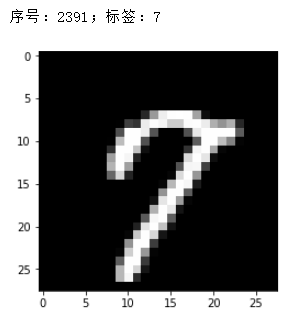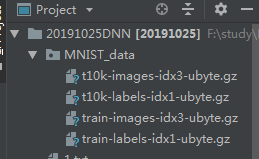本文将用Tensorflow框架训练Mnist数据集,搭建DNN(深度神经网络),比全连接神经网络多了一些功能,损失将以动态折线图方式展示
Mnist数据集是0-9十个数字构成的图片形式的数据集,每张图片是28*28的大小
导入tensorflow中带的mnist数据集,以one-hot的形式:
from tensorflow.examples.tutorials.mnist import input_data
mnist=input_data.read_data_sets(".\MNIST_data",one_hot=True)
往神经网络中喂数据的格式是[N,V]结构,整张图片不能直接传入神经网络,每张图片是28乘以28,要变成784*1,即把每个像素挨个排列送进网络
self.x=tf.placeholder(shape=[None,784],dtype=tf.float32)
这里用了三层神经网络,感知机模型f(wx+b),f为激活函数,w为权重,从标准正态分布中截取,b为偏置,设置为0,标准差是0.001
self.w1=tf.Variable(tf.truncated_normal(shape=[784,256],stddev=0.001,dtype=tf.float32))
self.b1=tf.Variable(tf.zeros(shape=[256],dtype=tf.float32))
self.w2 = tf.Variable(tf.truncated_normal(shape=[256, 128],stddev=0.001, dtype=tf.float32))
self.b2 = tf.Variable(tf.zeros(shape=[128], dtype=tf.float32))
self.w3 = tf.Variable(tf.truncated_normal(shape=[128, 10], stddev=0.001, dtype=tf.float32))
self.b3 = tf.Variable(tf.zeros(shape=[10], dtype=tf.float32))
这里为了减小计算量,提高训练时间,使用了dropout函数
self.dropout=tf.placeholder(dtype=tf.float32)。。。
dr_y2=tf.nn.dropout(y2,keep_prob=self.dropout)
定义前向通道forward,前两层使用rule作为激活函数,最后一层使用softmax激活(多分类问题最后一层要用softmax激活),并且用batch_normalization做归一化处理
def forward(self):
y1=tf.nn.relu(tf.layers.batch_normalization(tf.layers.batch_normalization(tf.matmul(self.x,self.w1)+self.b1)))
dr_y1=tf.nn.dropout(y1,keep_prob=self.dropout)
y2=tf.nn.relu(tf.layers.batch_normalization(tf.layers.batch_normalization(tf.matmul(dr_y1,self.w2)+self.b2)))
dr_y2=tf.nn.dropout(y2,keep_prob=self.dropout)
self.y3=tf.layers.batch_normalization(tf.matmul(dr_y2,self.w3)+self.b3)
self.output=tf.nn.softmax(self.y3)
定义损失函数loss,使用交叉熵损失函数softmax_cross_entropy_with_logits,具体用法请自行学习
def loss(self):
self.error=tf.reduce_mean(tf.nn.softmax_cross_entropy_with_logits(labels=self.y,logits=self.y3))
+param*tf.reduce_sum(self.w1**2)+param*tf.reduce_sum(self.w2**2)+param*tf.reduce_sum(self.w3**2)
定义后向函数backward,使用Adam优化器优化损失
def backfard(self):
# self.optimizer = tf.train.GradientDescentOptimizer(0.1).minimize(self.error)
self.optimizer = tf.train.AdamOptimizer(0.001).minimize(self.error)
之后就是主函数,实例化,喂数据,训练、验证,并使用matplotlib将损失以动态折线图的形式展示出来,下面是全部程序
import tensorflow as tf
import numpy as np
from tensorflow.examples.tutorials.mnist import input_data
mnist=input_data.read_data_sets(".\MNIST_data",one_hot=True)
import matplotlib.pyplot as plt
param=1
class Net:
def __init__(self):
self.x=tf.placeholder(shape=[None,784],dtype=tf.float32)
self.y=tf.placeholder(shape=[None,10],dtype=tf.float32)
self.w1=tf.Variable(tf.truncated_normal(shape=[784,256],stddev=0.001,dtype=tf.float32))
self.b1=tf.Variable(tf.zeros(shape=[256],dtype=tf.float32))
self.w2 = tf.Variable(tf.truncated_normal(shape=[256, 128],stddev=0.001, dtype=tf.float32))
self.b2 = tf.Variable(tf.zeros(shape=[128], dtype=tf.float32))
self.w3 = tf.Variable(tf.truncated_normal(shape=[128, 10], stddev=0.001, dtype=tf.float32))
self.b3 = tf.Variable(tf.zeros(shape=[10], dtype=tf.float32))
self.dropout=tf.placeholder(dtype=tf.float32)
def forward(self):
y1=tf.nn.relu(tf.layers.batch_normalization(tf.layers.batch_normalization(tf.matmul(self.x,self.w1)+self.b1)))
dr_y1=tf.nn.dropout(y1,keep_prob=self.dropout)
y2=tf.nn.relu(tf.layers.batch_normalization(tf.layers.batch_normalization(tf.matmul(dr_y1,self.w2)+self.b2)))
dr_y2=tf.nn.dropout(y2,keep_prob=self.dropout)
self.y3=tf.layers.batch_normalization(tf.matmul(dr_y2,self.w3)+self.b3)
self.output=tf.nn.softmax(self.y3)
def loss(self):
self.error=tf.reduce_mean(tf.nn.softmax_cross_entropy_with_logits(labels=self.y,logits=self.y3))
+param*tf.reduce_sum(self.w1**2)+param*tf.reduce_sum(self.w2**2)+param*tf.reduce_sum(self.w3**2)
def backfard(self):
# self.optimizer = tf.train.GradientDescentOptimizer(0.1).minimize(self.error)
self.optimizer = tf.train.AdamOptimizer(0.001).minimize(self.error)
def accuracy(self):
y=tf.equal(tf.argmax(self.y,axis=1),tf.argmax(self.output,axis=1))
self.acc=tf.reduce_mean(tf.cast(y,dtype=tf.float32))
if __name__ == '__main__':
net=Net()
net.forward()
net.loss()
net.backfard()
net.accuracy()
init=tf.global_variables_initializer()
plt.ion()
a=[]
b=[]
c=[]
with tf.Session() as sess:
sess.run(init)
for i in range(50000):
xs,ys=mnist.train.next_batch(100)
error,_=sess.run([net.error,net.optimizer],feed_dict={net.x:xs,net.y:ys,net.dropout:0.5})
if i%100==0:
xss,yss=mnist.validation.next_batch(100)
_error,_output,acc=sess.run([net.error,net.output,net.acc],feed_dict={net.x:xss,net.y:yss,net.dropout:1})
label=np.argmax(yss[0])
out=np.argmax(_output[0])
print(acc)
print("label:",label)
print("error:",error,"output:",out)
print("_error:",_error)
a.append(i)
b.append(error)
c.append(_error)
plt.clf()
train,=plt.plot(a,b,color="red")
validation,=plt.plot(a,c,color="blue")
plt.legend([train,validation],["train","validation"])
plt.pause(0.01)
plt.ioff()
运行之前请确认mnist数据集是否已经加载进来,如果没有要自行下载mnist数据集并粘贴到这里

运行结果:这里不展示动态图,只截取了刚开始运行时的损失和训练一段时间之后的损失
刚开始训练的损失

训练一段时间之后的损失

结论:可以看出,用DNN网络训练mnist数据集,效果还是很好的,毕竟mnist数据集比较简单,比较好训练,最后的损失是很小的。
转载或者引用请注明来源!
